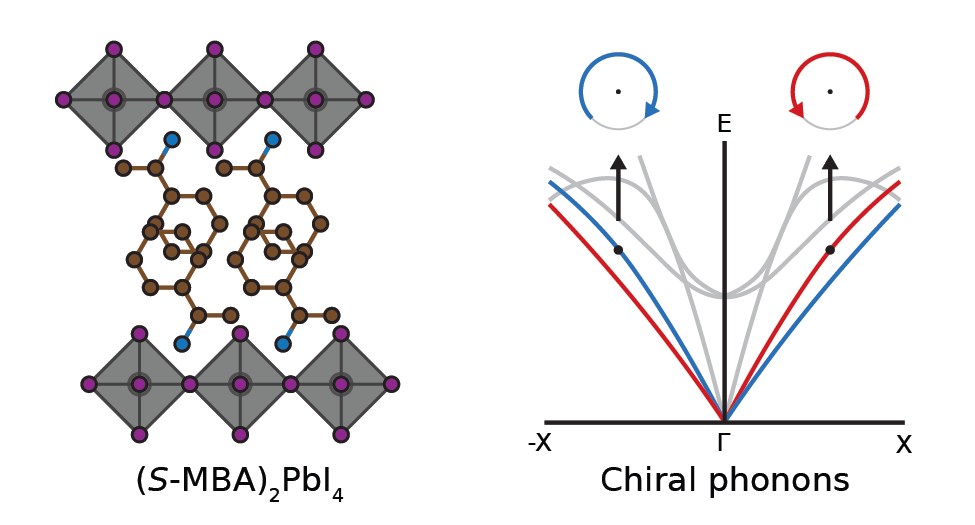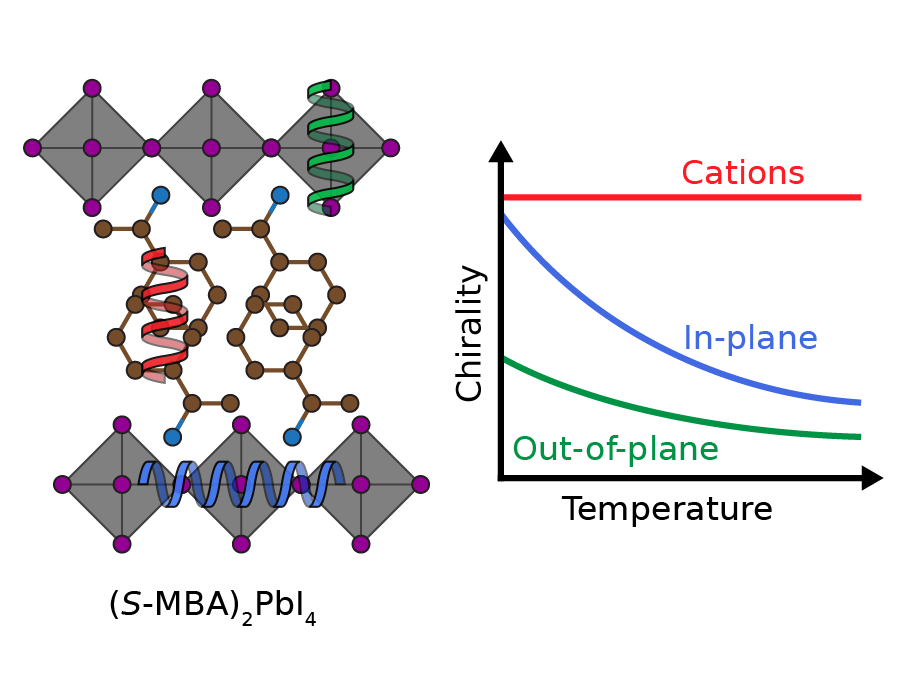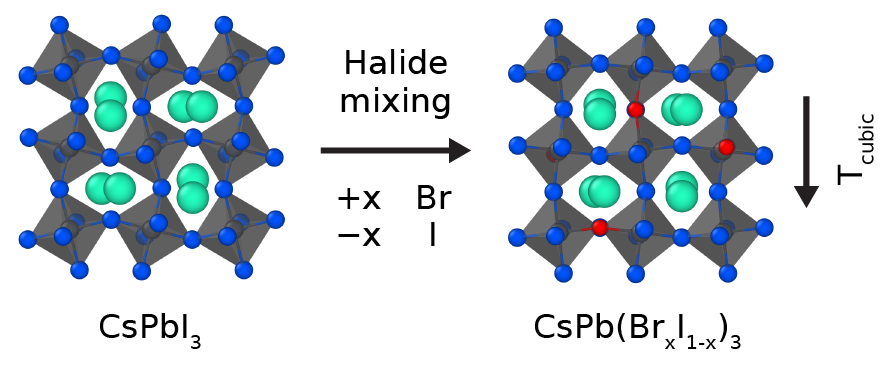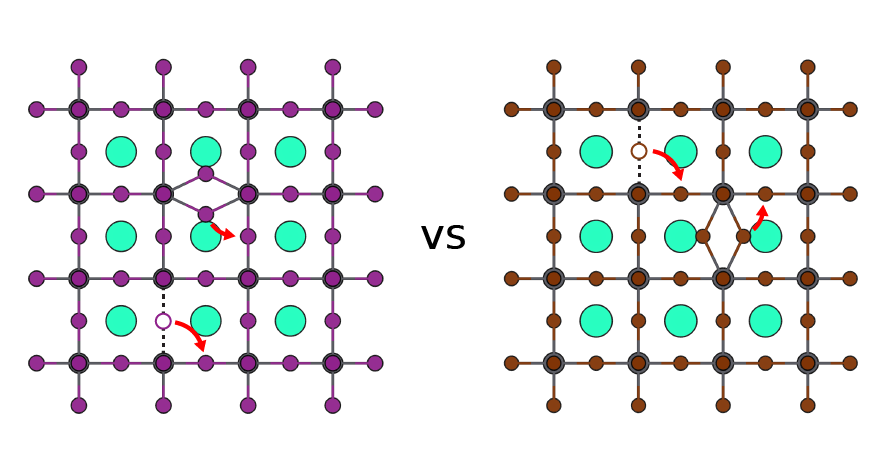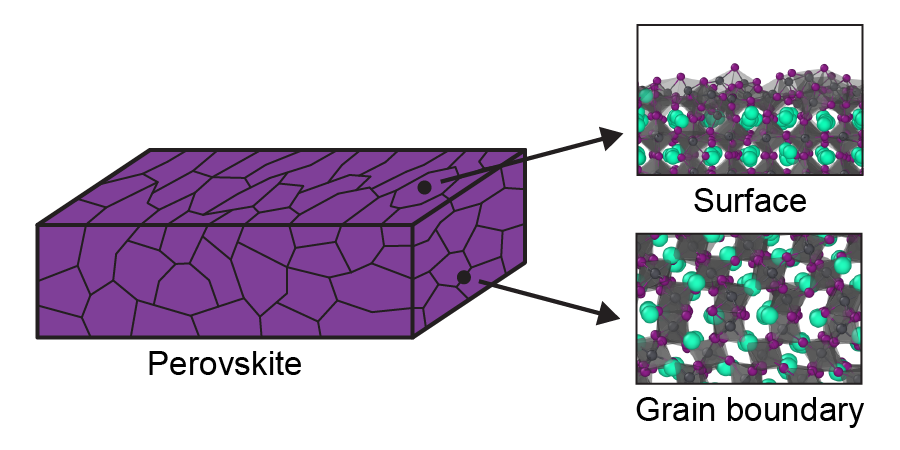publications
publications by catergories in reversed chronological order; an up-to-date list is available on Google Scholar
preprints
articles
2025
- Chiral Phonons in 2D Halide PerovskitesNano Lett., XX, XXXX--XXXX (2025).
Phonons in chiral crystal structures can be circularly polarized, making them chiral. Chiral phonons carry angular momentum, which is observable in heat currents, and, via coupling to electron spin, in spin currents. Two-dimensional (2D) halide perovskites, versatile direct band gap semiconductors, can easily form chiral structures by incorporating chiral organic cations. As a result, they exhibit phenomena such as chirality-induced spin selectivity (CISS) and the spin Seebeck effect, although the underlying mechanisms remain unclear. Using on-the-fly machine-learning force fields trained against density functional theory calculations, we confirm the presence of chiral phonons, a potential key factor for these effects. Our analysis reveals that low-energy phonons, originating from the inorganic framework, primarily exhibit chirality. Under a temperature gradient, these chiral phonons generate substantial angular momentum, leading to experimentally observable effects. These findings position chiral 2D perovskites as a promising platform for exploring the interplay among phononic, electronic, spintronic, and thermal properties.
- Tracing Ion Migration in Halide Perovskites with Machine Learned Force FieldsViren Tyagi, Mike Pols, Geert Brocks, and Shuxia TaoJ. Phys. Chem. Lett., 16, 5153--5159 (2025).
Halide perovskite optoelectronic devices suffer from chemical degradation and current-voltage hysteresis induced by migration of highly mobile charged defects. Atomic scale molecular dynamics simulations can capture the motion of these ionic defects, but classical force fields are too inflexible to describe their dynamical charge states. Using CsPbI\(_{3}\) as a case study, we develop machine learned force fields from density functional theory calculations and study the diffusion of charged halide interstitial and vacancy defects in bulk CsPbI\(_{3}\). We find that negative iodide interstitials and positive iodide vacancies, the most stable charge states for their respective defect type, migrate at similar rates at room temperature. Neutral interstitials are faster, but neutral vacancies are one order of magnitude slower. Oppositely charged interstitials and vacancies, as they can occur in device operation or reverse bias conditions, are significantly slower and can be considered relatively immobile.
- Humidity Disrupts Structural and Chiroptical Properties of Chiral 2D PerovskitesRaushan N. Nurdillayeva, Raphael F. Moral, Mike Pols, Do-Kyoung Lee, Virginia Altoe, Craig P. Schwartz, Shuxia Tao, and Carolin M. Sutter-FellaACS Nano, 19, 11348--11357 (2025).
Chiral two-dimensional (2D) hybrid organic--inorganic metal halide perovskite semiconductors have emerged as an exceptional material platform with many design opportunities for spintronic applications. However, a comprehensive understanding of changes to the crystal structure and chiroptical properties upon exposure to atmospheric humidity has not been established. We demonstrate phase degradation to the 1D (MBA)PbI3 (MBA = methylbenzylammonium) and the hypothetical (MBA)3PbI5{$\cdot$}H2O hydrate phases, accompanied by a reduction and disappearance of the chiroptical response. First-principle simulations show that water molecules preferentially locate at the interface between the organic cations and the inorganic framework, thereby disrupting the hydrogen bonding, impacting both the structural chirality and stability of the material. These findings provide critical insights into phase degradation mechanisms and their impact on chiroptical activity in chiral 2D perovskites.
2024
- Temperature-Dependent Chirality in Halide PerovskitesJ. Phys. Chem. Lett., 15, 8057—8064 (2024).
With the use of chiral organic cations in two-dimensional metal halide perovskites, chirality can be induced in the metal halide layers, which results in semiconductors with intriguing chiral optical and spin-selective transport properties. The chiral properties strongly depend upon the temperature, despite the basic crystal symmetry not changing fundamentally. We identify a set of descriptors that characterize the chirality of metal halide perovskites, such as MBA\(_{2}\)PbI\(_{4}\), and study their temperature dependence using molecular dynamics simulations with on-the-fly machine-learning force fields obtained from density functional theory calculations. We find that, whereas the arrangement of organic cations remains chiral upon increasing the temperature, the inorganic framework loses this property more rapidly. We ascribe this to the breaking of hydrogen bonds that link the organic with the inorganic substructures, which leads to a loss of chirality transfer.
- Improving the Water Resistance of Bi-Based Perovskite-Inspired Materials for Vapor-Phase Photocatalytic Overall Water SplittingAntonio J. Chacón-García, Herme G. Baldovi, Mike Pols, Shuxia Tao , Sofia Calero, Sergio Navalón, Iñigo J. Vitorica-Yrezabal, Antonio Rodríguez-Diéguez, Hermenegildo García, Patricia Horcajada, and 1 more authorSolar RRL, 8, 2400250 (2024).
Lead halide perovskites are well known for their exceptional photophysical and electronic properties, which have placed them at the forefront of challenging optoelectronic applications and solar-to-fuel conversion. However, their air/water instability, combined with their toxicity, is still a critical problem that has slowed down their commercialization. In this sense, bismuth-based halide derivatives attract much interest as a potentially safer, air-stable alternative. Herein, a novel Bi-based perovskite-inspired material, IEF-19 (IEF stands for IMDEA Energy Framework), which contains a bulky aromatic cation (1,5-diammonium naphthalene), is prepared. Additionally, an N-alkylation strategy is successfully employed to achieve four water-stable perovskite-inspired materials, which contains diammonium naphthalene cations that are tetra-alkylated by methyl, ethyl, propyl, and butyl groups. Moreover, computational studies are performed to gain a deeper understanding of the intrinsic structural stability and affinity of water molecules for Bi-based perovskite-inspired materials. Importantly, the air- and water-stable IEF-19-Et (i.e., stable at least 12 months under ambient conditions and 3 weeks in contact with water) is found to be an active photocatalyst for vapor-phase overall water splitting in the absence of any sacrificial agent under both ultraviolet--visible or simulated sunlight irradiation. This material exhibits an estimated apparent quantum yield of 0.08% at 400 nm, partially explained by its adequate energy band level diagram.
- Mixing I and Br in Inorganic Perovskites: Atomistic Insights from Reactive Molecular Dynamics SimulationsJ. Phys. Chem. C, 128, 4111—4118 (2024).
All-inorganic halide perovskites have received a great deal of attention as attractive alternatives to overcome the stability issues of hybrid halide perovskites that are commonly associated with organic cations. To find a compromise between the optoelectronic properties of CsPbI\(_{3}\) and CsPbBr\(_{3}\), perovskites with CsPb(Br\(_{x}\)I\(_{1-x}\))\(_{3}\) mixed compositions are commonly used. An additional benefit is that without sacrificing the optoelectronic properties for applications such as solar cells or light-emitting diodes, small amounts of Br in CsPbI\(_{3}\) can prevent the inorganic perovskite from degrading to a photo-inactive non-perovskite yellow phase. Despite indications that strain in the perovskite lattice plays a role in the stabilization of the material, a full understanding of such strain is lacking. Here, we develop a reactive force field (ReaxFF) for perovskites starting from our previous work for CsPbI\(_{3}\), and we extend this force field to CsPbBr\(_{3}\) and mixed CsPb(Br\(_{x}\)I\(_{1-x}\))\(_{3}\) compounds. This force field is used in large-scale molecular dynamics simulations to study perovskite phase transitions and the internal ion dynamics associated with the phase transitions. We find that an increase of the Br content lowers the temperature at which the perovskite reaches a cubic structure. Specifically, by substituting Br for I, the smaller ionic radius of Br induces a strain in the lattice that changes the internal dynamics of the octahedra. Importantly, this effect propagates through the perovskite lattice ranging up to distances of 2 nm, explaining why small concentrations of Br in CsPb(Br\(_{x}\)I\(_{1-x}\))\(_{3}\) (\(x\) \( \leq \) 1/4) have a significant impact on the phase stability of mixed halide perovskites.
2023
- The Role of Sulfur in Sulfur-Doped Copper(I) Iodide p-Type Transparent ConductorsAdeem Saeed Mirza, Mike Pols, Wiria Soltanpoor, Shuxia Tao, Geert Brocks, and Monica Morales-MasisMatter, 6, 4306—4320 (2023).
CuI has been the best-known p-type transparent conductor (TC) for years, yet its conductivity still lags behind n-type TCs. Herein, we demonstrate S-doped CuI films via pulsed laser deposition and provide an in-depth defect analysis to describe its enhanced conductivity. Combining compositional and optoelectronic characterizations of the films, we show that 3 atom % S incorporation in CuI leads to an increase in hole carrier density from ~8×10\(^{19}\) to ~9×10\(^{20}\) cm\(^{-3}\), resulting in a conductivity boost from 78 to 435~S⋅cm\(^{-1}\) while maintaining >75% transparency in the visible spectrum. The increase in carrier density is linked to the formation of a Cu\(_{x}\)S amorphous phase at grain boundaries and copper-vacancy-rich phases intragrain, the latter suggested by defect calculations. The high conductivities of the S:CuI films validate the recently reported high figure of merit and motivate further exploration of dopants and alloy strategies with CuI to achieve high-performing p-type TCs.
- Discrete Elemental Distributions inside a Single Mixed-Halide Perovskite Nanocrystal for the Self-Assembly of Multiple Quantum-Light SourcesJinqiu Liu*, Chao Zhu*, Mike Pols*, Zhen Zhang*, Fengrui Hu, Lin Wang, Chunfeng Zhang, Zheng Liu, Shuxia Tao, Min Xiao, and 1 more authorNano Lett., 23, 10089—10096 (2023).
An in-depth understanding of the structure--property relationships in semiconductor mixed-halide perovskites is critical for their potential applications in various light-absorbing and light-emitting optoelectronic devices. Here we show that during the crystal growth of mixed-halide CsPbBr\(_{1.2}\)I\(_{1.8}\) nanocrystals (NCs), abundant Ruddlesden--Popper (RP) plane stacking faults are formed to release the lattice strain. These RP planes hinder the exchange of halide species across them, resulting in the presence of multiple nanodomains with discrete mixed-halide compositions inside a single CsPbBr\(_{1.2}\)I\(_{1.8}\) NC. Photoluminescence peaks from these pre-segregated nanodomains, whose correlated intensity and wavelength variations signify the interactions of coupled quantum dots within a single CsPbBr\(_{1.2}\)I\(_{1.8}\) NC, can be simultaneously resolved at cryogenic temperature. Our findings thus point to a fascinating scenario in which a semiconductor nanostructure can be further divided into multiple quantum-light sources, the interaction and manipulation of which will promote novel photophysics to facilitate their potential applications in quantum information technologies.
- Over-18%-Efficiency Quasi-2D Ruddlesden—Popper Pb—Sn Mixed Perovskite Solar Cells by Compositional EngineeringZhaotong Qin, Mike Pols, Minchao Qin, Jianquan Zhang, He Yan, Shuxia Tao, and Xinhui LuACS Energy Lett., 8, 3188—3195 (2023).
Quasi-two-dimensional (2D) Pb--Sn mixed perovskites show great potential in applications of single and tandem photovoltaic devices, but they suffer from low efficiencies due to the existence of horizontal 2D phases. Here, we obtain a record high efficiency of 18.06% based on 2D \(\langle n \rangle\) = 5 Pb—Sn mixed perovskites (iso-BA\(_{2}\)MA\(_{4}\)(Pb\(_{x}\)Sn\(_{1-x}\))\(_{5}\)I\(_{16}\), \(_{x}\) = 0.7), by optimizing the crystal orientation through a regulation of the Pb/Sn ratio. We find that Sn-rich precursors give rise to a mixture of horizontal and vertical 2D phases. Interestingly, increasing the Pb content can not only entirely suppress the unwanted horizontal 2D phase in the film but also enhance the growth of vertical 2D phases, thus significantly improving the device performance and stability. It is suggested that an increase of the Pb content in the Pb--Sn mixed systems facilitates the incorporation of iso-butylammonium (iso-BA\(^{+}\)) ligands in vertically oriented perovskites because of the reduced lattice strain and increased interaction between the organic ligands and inorganic framework. Our work sheds light on the optimal conditions for fabricating stable and efficient 2D Pb--Sn mixed perovskite solar cells.
- How Fast Do Defects Migrate in Halide Perovskites: Insights from On-the-Fly Machine-Learned Force FieldsMike Pols, Victor Brouwers, Sofía Calero, and Shuxia TaoChem. Commun., 59, 4660—4663 (2023).
The migration of defects plays an important role in the stability of halide perovskites. It is challenging to study defect migration with experiments or conventional computer simulations. The former lacks an atomic-scale resolution and the latter suffers from short simulation times or a lack of accuracy. Here, we demonstrate that machine-learned force fields, trained with an on-the-fly active learning scheme against accurate density functional theory calculations, allow us to probe the differences in the dynamical behaviour of halide interstitials and halide vacancies in two closely related compositions CsPbI\(_{3}\) and CsPbBr\(_{3}\). We find that interstitials migrate faster than vacancies, due to the shorter migration paths of interstitials. Both types of defects migrate faster in CsPbI\(_{3}\) than in CsPbBr\(_{3}\). We attribute this to the less compact packing of the ions in CsPbI\(_{3}\), which results in a larger motion of the ions and thus more frequent defect migration jumps.
2022
- What Happens at Surfaces and Grain Boundaries of Halide Perovskites: Insights from Reactive Molecular Dynamics Simulations of CsPbI\(_{3}\)ACS Appl. Mater. Interfaces, 14, 40841—40850 (2022).
The commercialization of perovskite solar cells is hindered by the poor long-term stability of the metal halide perovskite (MHP) light-absorbing layer. Solution processing, the common fabrication method for MHPs, produces polycrystalline films with a wide variety of defects, such as point defects, surfaces, and grain boundaries. Although the optoelectronic effects of such defects have been widely studied, the evaluation of their impact on the long-term stability remains challenging. In particular, an understanding of the dynamics of degradation reactions at the atomistic scale is lacking. In this work, using reactive force field (ReaxFF) molecular dynamics simulations, we investigate the effects of defects, in the forms of surfaces, surface defects, and grain boundaries, on the stability of the inorganic halide perovskite CsPbI\(_{3}\). Our simulations establish a stability trend for a variety of surfaces, which correlates well with the occurrence of these surfaces in experiments. We find that a perovskite surface degrades by progressively changing the local geometry of PbI\(_{x}\) octahedra from corner- to edge- to face-sharing. Importantly, we find that Pb dangling bonds and the lack of steric hindrance of I species are two crucial factors that induce degradation reactions. Finally, we show that the stability of these surfaces can be modulated by adjusting their atomistic details, by either creating additional point defects or merging them to form grain boundaries. While in general additional defects, particularly when clustered, have a negative impact on the material stability, some grain boundaries have a stabilizing effect, primarily because of the additional steric hindrance.
- Refined GFN1-xTB Parameters for Engineering Phase-Stable CsPbX\(_{3}\) PerovskitesSander Raaijmakers, Mike Pols, José Manuel Vicent-Luna, and Shuxia TaoJ. Phys. Chem. C, 126, 9587—9596 (2022).
Halide perovskites are a promising class of materials for optoelectronic applications due to their excellent optoelectronic performance. However, they suffer from several dynamical degradation problems, the characterization of which is challenging. Atomic scale simulations can provide valuable insights; however, the high computational cost of first-principles methods such as DFT makes it difficult to model dynamical processes in large perovskite systems. In this work, we present refined GFN1-xTB parameters for the accurate description of structural and dynamical properties of CsPbBr\(_{3}\), CsPbI\(_{3}\), and CsPb(I\(_{1-x}\)Br\(_{x}\))\(_{3}\). Our molecular dynamics simulations show that the phase stability is strongly correlated to the displacement of ions in the perovskites. In the low temperature orthorhombic phase, directional movement of the Cs cations increases their distance to the surrounding halides, initiating a transition to the nonperovskite phase. However, once enough thermal energy is available, the increased Cs--halide distance can be compensated by increased halide fluctuations, resulting in a transition to the phase-stable tetragonal or cubic phases. Furthermore, we find the mixing of halides increases halide displacement over a significant range of temperatures, resulting in lower phase transition temperatures and therefore improved phase stability.
- A ReaxFF Molecular Dynamics Study of Hydrogen Diffusion in Ruthenium—The Role of Grain BoundariesChidozie Onwudinanti, Mike Pols, Geert Brocks, Vianney Koelman, Adri C. T. van Duin, Thomas Morgan, and Shuxia TaoJ. Phys. Chem. C, 126, 5950—5959 (2022).
Ruthenium (Ru) thin films are used as protective caps for the multilayer mirrors in extreme ultraviolet lithography machines. When these mirrors are exposed to atomic hydrogen (H), it can permeate through Ru, leading to the formation of hydrogen-filled blisters on the mirrors. H has been shown to exhibit low solubility in bulk Ru, but the nature of H diffusion through Ru and its contribution to the mechanisms of blistering remain unknown. This work makes use of reactive molecular dynamics simulations to study the influence of imperfections in a Ru film on the behavior of H. For the Ru/H system, a ReaxFF force field which reproduces structures and energies obtained from quantum-mechanical calculations was parametrized. Molecular dynamics simulations have been performed with the newly developed force field to study the effect of tilt and twist grain boundaries on the overall diffusion behavior of H in Ru. Our simulations show that the tilt and twist grain boundaries provide energetically favorable sites for hydrogen atoms and act as sinks and highways for H. They therefore block H transport across their planes and favor diffusion along their planes. This results in the accumulation of hydrogen at the grain boundaries. The strong effect of the grain boundaries on hydrogen diffusion suggests tailoring the morphology of ruthenium thin films as a means to curb the rate of hydrogen permeation.
2021
- Atomistic Insights Into the Degradation of Inorganic Halide Perovskite CsPbI\(_{3}\): A Reactive Force Field Molecular Dynamics StudyMike Pols, José Manuel Vicent-Luna, Ivo Filot, Adri C. T. van Duin, and Shuxia TaoJ. Phys. Chem. Lett., 12, 5519—5525 (2021).
Halide perovskites make efficient solar cells but suffer from several stability issues. The characterization of these degradation processes is challenging because of the limited spatiotemporal resolution in experiments and the absence of efficient computational methods to study these reactive processes. Here, we present the first reactive force field for molecular dynamics simulations of the phase instability and the defect-induced degradation in CsPbI\(_{3}\). We find that the phase transitions are driven by the anharmonic fluctuations of the atoms in the perovskite lattice. At low temperatures, the Cs cations tend to move away from their preferential positions, resulting in worse contacts with the surrounding metal halide framework which initiates the conversion to a nonperovskite phase. Moreover, our simulations of defective structures reveal that, although both iodine vacancies and interstitials are mobile in the perovskite lattice, the vacancies have a detrimental effect on the stability, leading to the decomposition of perovskites to PbI\(_{2}\).
- Decoupling the Effects of Defects on Efficiency and Stability through Phosphonates in Stable Halide Perovskite Solar CellsHaibing Xie, Zaiwei Wang, Zehua Chen, Carlos Pereyra, Mike Pols, Krzysztof Gałkowski, Miguel Anaya, Shuai Fu, Xiaoyu Jia, Pengyi Tang, and 20 more authorsJoule, 5, 1246—1266 (2021).
Understanding defects is of paramount importance for the development of stable halide perovskite solar cells (PSCs). However, isolating their distinctive effects on device efficiency and stability is currently a challenge. We report that adding the organic molecule 3-phosphonopropionic acid (H3pp) to the halide perovskite results in unchanged overall optoelectronic performance while having a tremendous effect on device stability. We obtained PSCs with ∼21% efficiency that retain ∼100% of the initial efficiency after 1,000 h at the maximum power point under simulated AM1.5G illumination. The strong interaction between the perovskite and the H3pp molecule through two types of hydrogen bonds (H⋅⋅⋅I and O⋅⋅⋅H) leads to shallow point defect passivation that has a significant effect on device stability but not on the non-radiative recombination and device efficiency. We expect that our work will have important implications for the current understanding and advancement of operational PSCs.
2020
- Engineering the Phases and Heterostructures of Ultrathin Hybrid Perovskite NanosheetsYan Sun, Yao Yin, Mike Pols, Jingxian Zhong, Zhen Huang, Bowen Liu, Jinqiu Liu, Wei Wang, Hongguang Xie, Guixiang Zhan, and 13 more authorsAdv. Mater., 32, 2002392 (2020).
Low-dimensional perovskites have gained increasing attention recently, and engineering their material phases, structural patterning and interfacial properties is crucial for future perovskite-based applications. Here a phase and heterostructure engineering on ultrathin perovskites, through the reversible cation exchange of hybrid perovskites and efficient surface functionalization of low-dimensional materials, is demonstrated. Using PbI\(_{2}\) as precursor and template, perovskite nanosheets of varying thickness and hexagonal shape on diverse substrates is obtained. Multiple phases, such as PbI\(_{2}\), MAPbI\(_{3}\) and FAPbI\(_{3}\), can be flexibly designed and transformed as a single nanosheet. A perovskite nanosheet can be patterned using masks made of 2D materials, fabricating lateral heterostructures of perovskite and PbI\(_{2}\). Perovskite-based vertical heterostructures show strong interfacial coupling with 2D materials. As a demonstration, monolayer MoS\(_{2}\)/MAPbI\(_{3}\) stacks give a type-II heterojunction. The ability to combine the optically efficient perovskites with versatile 2D materials creates possibilities for new designs and functionalities.
2018
- Effect of Triplet Confinement on Triplet—Triplet Annihilation in Organic Phosphorescent Host—Guest SystemsArnout Ligthart, Xander Vries, Le Zhang, Mike Pols, Peter A. Bobbert, Harm Eersel, and Reinder CoehoornAdv. Funct. Mater., 28, 1804618 (2018).
The efficiency of phosphorescent organic light emitting diodes (OLEDs) shows a decrease with increasing luminance ("roll-off"). One of the contributions to the roll-off is triplet--triplet annihilation (TTA). TTA is the process of energy transfer from one triplet exciton to another, after which the excited exciton decays nonradiatively to the lowest triplet state. In this study, the TTA-rate is measured for a large number of emissive materials consisting of a small concentration of phosphorescent "guest" molecules, with emission colors across the entire visible range, embedded in various host materials. It is found that the TTA-rate does not only depend on the direct interaction rate between the excitons on the guest molecules, but also on the difference in triplet energy \(\Delta E_{\mathrm{T}}\) of the host and guest molecules: when \(\Delta E_{\mathrm{T}}\) is smaller than about 0.20 eV, diffusion of excitons via the host molecules leads to a significant enhancement of the TTA-rate. By varying the guest concentration and using kinetic Monte Carlo simulations, the roles of the direct interaction, guest-mediated diffusion, and host-mediated diffusion are disentangled.
